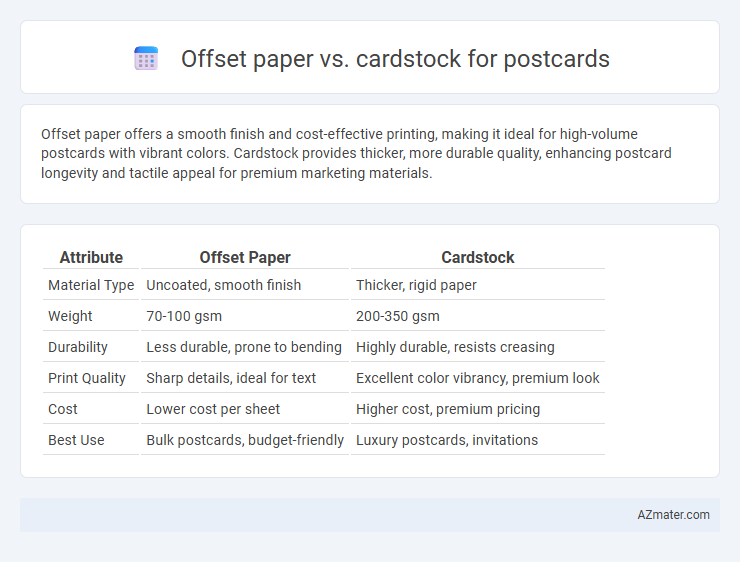Offset paper offers a smooth finish and cost-effective printing, making it ideal for high-volume postcards with vibrant colors. Cardstock provides thicker, more durable quality, enhancing postcard longevity and tactile appeal for premium marketing materials.
Table of Comparison
| Attribute | Offset Paper | Cardstock |
|---|---|---|
| Material Type | Uncoated, smooth finish | Thicker, rigid paper |
| Weight | 70-100 gsm | 200-350 gsm |
| Durability | Less durable, prone to bending | Highly durable, resists creasing |
| Print Quality | Sharp details, ideal for text | Excellent color vibrancy, premium look |
| Cost | Lower cost per sheet | Higher cost, premium pricing |
| Best Use | Bulk postcards, budget-friendly | Luxury postcards, invitations |
Introduction to Postcard Paper Choices
Postcard paper choices primarily include offset paper and cardstock, each offering distinct advantages for print quality and durability. Offset paper is smooth and ideal for high-volume, vibrant color printing, while cardstock provides thicker, sturdier support, enhancing postcard longevity and tactile appeal. Selecting the right paper depends on the desired balance between visual impact and physical resilience for effective direct mail marketing.
What is Offset Paper?
Offset paper is a high-quality, uncoated paper commonly used in commercial printing processes like offset lithography, known for its smooth texture and excellent ink absorption that ensures sharp image reproduction. Unlike cardstock, offset paper is thinner and more flexible, making it ideal for vibrant, detailed postcards without the rigidity of thicker paper weights. It balances durability and print clarity, providing a professional finish to postcards needing fine graphic detail and rich colors.
What is Cardstock?
Cardstock is a thick, durable paper stock that ranges from 50 lb to 110 lb in weight, offering a sturdy and rigid feel ideal for postcards that require a premium finish and longevity. Unlike offset paper, which is lighter and more porous, cardstock provides greater rigidity and resistance to wear, making it suitable for postcards that need to withstand handling and mailing without bending. Its smooth surface and ability to hold vibrant ink make cardstock the preferred choice for high-quality, visually appealing postcards.
Visual Appeal: Comparing Finishes
Offset paper offers a smooth, matte finish that enhances vibrant color reproduction for postcards, while cardstock provides a thicker, more durable surface with a tactile, often glossy or satin finish that elevates visual appeal. The choice between offset paper and cardstock influences the postcard's perceived quality, with cardstock delivering a premium look and feel that stands out in physical mail. Selecting the right finish on cardstock can also add unique textures and reflective qualities, making designs more eye-catching and enhancing visual impact.
Durability and Handling
Offset paper offers moderate durability with a smooth finish, making it suitable for postcards that require sharp print quality and easy handling during mailing. Cardstock provides superior durability due to its thicker, stiffer composition, ideal for postcards needing extra rigidity and resistance to bending or damage. The choice between offset paper and cardstock impacts the postcard's longevity and tactile experience, with cardstock favored for premium durability and offset paper for cost-effective, lightweight handling.
Print Quality Differences
Offset paper offers a smoother finish and higher opacity, resulting in vibrant, sharp images and crisp text for postcards, whereas cardstock provides a thicker, sturdier feel with a more textured surface that may slightly absorb ink, affecting print clarity. Offset printing on offset paper typically delivers consistent color reproduction and finer details, making it ideal for intricate designs and photographic postcards. Cardstock's durability enhances postcard longevity but may sacrifice some print sharpness due to ink absorption and surface texture variations.
Cost Considerations
Offset paper typically offers a more cost-effective solution for postcard printing due to its lighter weight and lower material expenses, making it ideal for high-volume runs. Cardstock, while more expensive per sheet, provides superior thickness and durability, justifying its higher cost for premium, long-lasting postcards. Choosing between offset paper and cardstock depends largely on budget constraints and the desired quality of the finished postcard product.
Ideal Usage Scenarios
Offset paper excels for postcards requiring vibrant color reproduction and fine detail, making it ideal for promotional mailers and photo postcards with smooth finishes. Cardstock offers superior thickness and durability, perfect for postcards needing enhanced rigidity, such as invitations or keepsakes intended for long-term handling. Choosing offset paper suits bulk mail campaigns, while cardstock serves best for premium, tactile impressions and impactful first impressions.
Environmental Impact
Offset paper for postcards generally has a lower environmental impact due to its thinner, less resource-intensive production compared to cardstock, which is thicker and requires more materials and energy to manufacture. Cardstock often involves higher carbon emissions and greater water usage, contributing to more significant environmental strain during its lifecycle. Choosing sustainably sourced offset paper or recycled cardstock can mitigate ecological footprints while maintaining postcard quality.
Choosing the Right Paper for Your Postcards
Offset paper offers a smooth surface ideal for vibrant, detailed printing, making it suitable for high-quality postcards with intricate designs or photos. Cardstock, thicker and more durable than offset paper, provides a sturdy feel that ensures postcards withstand mailing and handling, enhancing their perceived value and longevity. Selecting the right paper depends on your postcard's purpose: choose offset paper for sharp, colorful images and cardstock for a robust, tactile experience that leaves a lasting impression.

Infographic: Offset paper vs Cardstock for Postcard
 azmater.com
azmater.com